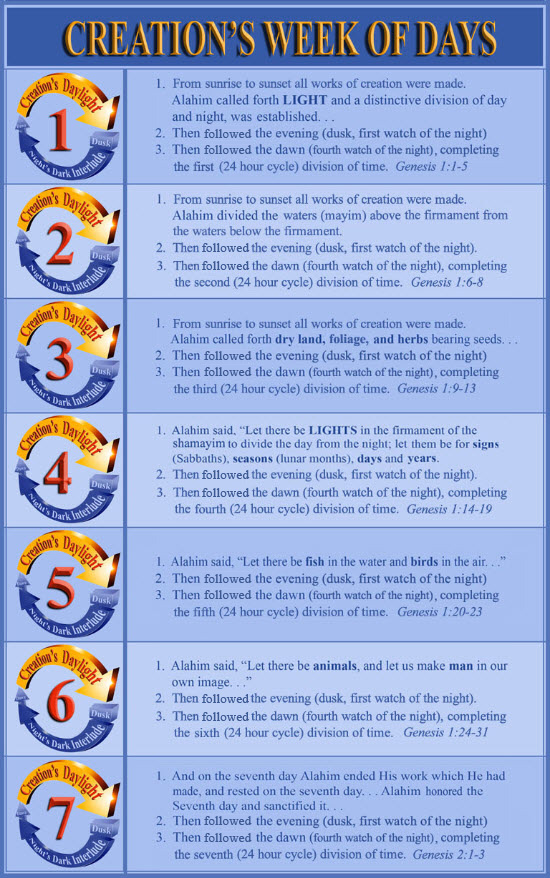A Day in Genesis – Genesis 1:1-5
A Day in Genesis – Genesis 1:1-5
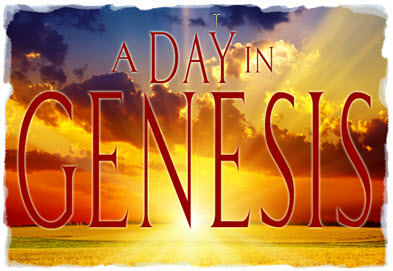
The following interlinear word study is intended to reveal that there are yet precious truths to be discovered that have remained hidden just below the surface of all the Bible translations. The most amazing revelations that are coming to light in this and other word studies tend to be on the theme of time, revealing the true and vital astronomical beacons the Creator ordained to govern them.
Here in this article, “A Day in Genesis – Genesis 1:1-5,” it is demonstrated that during the first seven days of creation, it was the LIGHT only that was to be called “day,” while the “darkness” was to be called night. These two portions of a 24-hour civil calendar date cycle were designed to forever distinguish one from the other. The night was never intended to occupy any portion of time called “day.” And, a “day” was to be a twelve-hour period of “daylight” only that begins at sunrise and ends at sunset, as ruled by the sun (John 11:9).
The order of time was very important to our Creator. From nothingness, emptiness, and darkness, He called forth the LIGHT. The first thing He named was LIGHT. Darkness is not only the absence of LIGHT but the absence of “day” (daylight). While the darkness of night was to be the interim between two “daylights,” the Creator ordained that the lunar phases demarcate each civil calendar date and announce that the new day will begin the following morning at sunrise. Thus, each unique lunar phase forever distinguishes one daylight unit from another.
None of the marvelous acts of creation were accomplished during the “darkness of night” once the day and the night were distinctly severed from one another. However, the Eternal Most High Creator ordained that the first 24-hour “civil calendar date” was to be beaconed monthly by the full moon as His original and authentic start of months (Renewed Moon Day or New Moon Day), together with a specific starry constellation by night. This regular monthly event announced that the New Moon Day would commence at sunrise the next day. It is this Lunar-Astro Line time signature that distinguishes our Creator’s Kadosh (sacred) calendar from all other impostors.
“And he [the Beast power] shall think to change times and laws.” Daniel 7:25
Following this word study are 32 point-by-point questions and answers to help emphasize Disney Brings Marie to An Adidas Originals Capsule for 55th Anniversary of The Aristocats , OdegardcarpetsShops° , adidas slides price philippines today online these newly revealed truths.
![]() Questions and Commentary on a Day in Genesis – Genesis 1:1-5:
Questions and Commentary on a Day in Genesis – Genesis 1:1-5:
The Hebrew word “Alahim/Elohim” is a plural term that includes both the Almighty Father, Yahuah, and His Son, Yahusha, as together they created all things. Contrary to the text in most English translations, this first verse explicitly identifies the marvelous qualities of the Creator Himself as the ALEPH and TAV את (Greek – Alpha and Omega), meaning the first and the last, the beginning and the end of all things animate and inanimate.
2. What are the attributes of Alahim the Creator, as identified in verse 1?
Strikingly, the first mention of the shamayim (heavens) and the Eretz (earth) in verse one are not in reference to their being made but rather define the nature of the CREATOR ALAHIM. His title is the CREATOR OF THE SHAMAYIM AND THE EARTH. These define who He is above all. For He is the Aleph and Tav (Greek Alpha and Omega, first and last) of both the shamayim (heavens) and the Eretz (earth). These things that we see all around us did not exist without Him. He is the all-in-all of both. Nothing was created that did not come to be by the word of His mouth.
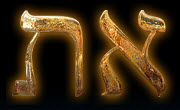 Of profound importance in this first verse of Genesis is the Hebrew word את (Aleph and Tav), which is used twice in this Hebrew text. Yet, in both cases, it has been curiously absent and utterly removed from the English translations. Add to this that the Hebrew את (Aleph and Tav) has been left out over 7,000 times throughout the translations of Scripture, effectively crafting a disconnect between what Yahusha haMashiach (the Messiah) declared concerning Himself in the Brit Hadasha (N.T.). He said, “I am the Alpha and Omega (Hebrew Aleph and Tav), the beginning and end, the first and the last.” Revelation 1:8; 1:11; 21:6; 22:13
Of profound importance in this first verse of Genesis is the Hebrew word את (Aleph and Tav), which is used twice in this Hebrew text. Yet, in both cases, it has been curiously absent and utterly removed from the English translations. Add to this that the Hebrew את (Aleph and Tav) has been left out over 7,000 times throughout the translations of Scripture, effectively crafting a disconnect between what Yahusha haMashiach (the Messiah) declared concerning Himself in the Brit Hadasha (N.T.). He said, “I am the Alpha and Omega (Hebrew Aleph and Tav), the beginning and end, the first and the last.” Revelation 1:8; 1:11; 21:6; 22:13
![]() But more significant still, this word את in the earlier paleo Hebrew, read from right to left, resembles an “A” lying on its side that takes on the appearance of a lamb slain. This is followed by the “Tav,” which looks exactly like a crucifixion cross. Together, this tells the story with an apt association with the first lamb slain in the Garden of Eden as the first promise of the coming Messiah. Then followed by the “Tav” cross, which identifies the method and time period in which the cross was to be utilized during the Roman occupation, for both the PROMISE and the PROVISION of the death of the LAMB of YAHUAH, who takes away the sins of the world. Wow!
But more significant still, this word את in the earlier paleo Hebrew, read from right to left, resembles an “A” lying on its side that takes on the appearance of a lamb slain. This is followed by the “Tav,” which looks exactly like a crucifixion cross. Together, this tells the story with an apt association with the first lamb slain in the Garden of Eden as the first promise of the coming Messiah. Then followed by the “Tav” cross, which identifies the method and time period in which the cross was to be utilized during the Roman occupation, for both the PROMISE and the PROVISION of the death of the LAMB of YAHUAH, who takes away the sins of the world. Wow!
This view is echoed and reechoed three times for emphasis in the book of Revelation in the Greek counterpart as the Alpha and Omega. For Yahusha, our Redeemer and Deliverer, identifies Himself as one with the Father at creation; therefore, He and His Father are the authors and finishers of our salvation. This carries profound implications for all those who look forward to His soon return. (For the popular Rabbinical view of the Hebrew word (eth #853), see bottom of the article.)
“And behold, I am coming quickly 200 - Riot Skateshop x Nike Reveals Two More Nike Low "Paisley" Colourways FZ1289 - Air Force 1 Crater White Copa, and My reward is with Me, to give to every one according to his work. I am the Alpha and the Omega, the beginning and the end, the first and the last.” Revelation 22:12-13
3. In the Word Study, Genesis 1:2 lists three conditions that existed prior to the first act of Creation. What were they?
Nothingness, emptiness, and darkness.
4. Since darkness was included in this pre-existing condition, then is it possible that it was the first thing Alahim created?
No! Just as our Creator did not create nothingness or emptiness, He also did not create darkness. Rather, darkness is a synonym for nothingness and emptiness, representing the pre-existing condition that was void of anything created. Darkness is the reality that exists in the absence of LIGHT.
5. In the second half of verse 2, the modern English Bible translations identify that Alahim/Elohim hovered over the face of the “waters.” But is this contextually accurate?
All of us have believed that Alahim/Elohim hovered over the face of “the waters (H#4325 מים).” We believed for the very reason that we were taught that the Scriptures are without error. Yet, translations provide grand opportunities for proactive errors, and one of the ways to recognize these is when the CONTEXT IS NOT CONSISTENT. The creation of water is not applicable until verse 6 or 9. To change the Hebrew word from “the waters” to “the shamayim” (heavens) is a difference of a single letter שׁ, which carries the “sh” sound in “sh mayim” שׁמים; otherwise, it remains as the word “mayim” מים (waters). With this said, this is not detrimental to the focus of this study, and I simply may be wrong on this point. But contextually, the focus seems to be on deep space, with Alahim/Elohim hovering over the face of deep space specifically rather than the waters. The next thing He did was separate the light from the darkness, which had nothing to do with water but everything to do with space. This is not a hardline stand and is not essential to this study.
6. According to verse 3 in this study, what was the first thing that Alahim spoke into existence? LIGHT!
7. The LIGHT called forth from the Creator on this first DAY did not come from the sun, moon, or stars, as they were not created until the fourth day, so where did this LIGHT come from?
It was the LIGHT of the CREATOR Himself, for it states in verse 4 that HE IS LIGHT.
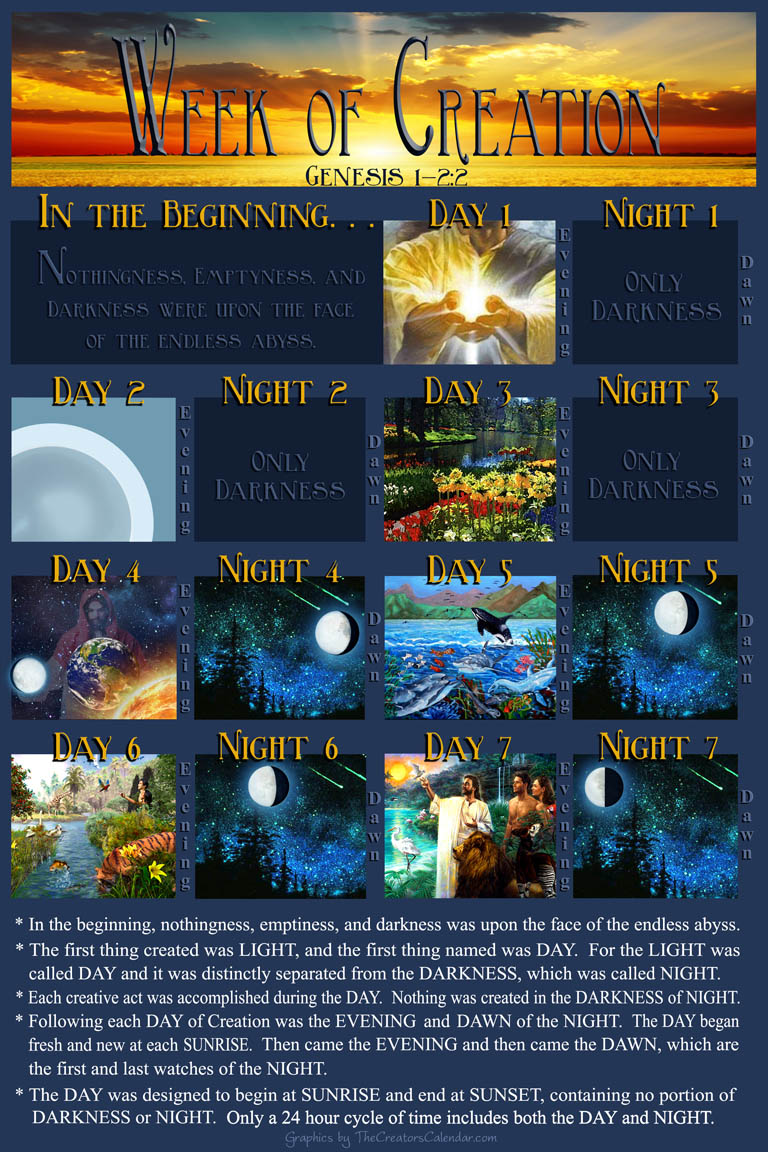 8. According to verse 4, what attributes are declared about the Creator?
8. According to verse 4, what attributes are declared about the Creator?
He is both LIGHT and GOODNESS.
9. What unique thing did the Creator do with the “LIGHT” and the “darkness” that can still be viewed in the heavens today?
He distinguished them by severing and dividing the light from the darkness. So today, as in all ages of earth’s history, darkness and light have never cohabited or had communion with each other.
For what fellowship has righteousness with lawlessness? And what communion has LIGHT with DARKNESS? Or what accord has the Messiah with Belial (ha Satan)? 2 Corinthians 6:14-15
10. In verse 4, what is the specific name Alahim gives for “LIGHT” to differentiate it from “darkness?”
He called it DAY. Therefore, DAY and LIGHT are synonymous terms.
11. Is it not self-evident that the LIGHT, which was called DAY, is the same DAYLIGHT we see each morning from sunrise to sunset all these years later?
Yes! Approximately 4,000 years after creation, the Messiah, who was present as the creative WORD, came to earth and, as a second witness, defined the length of the “day” as a twelve-hour period of daylight.
Yahusha answered, “Are there not twelve hours in the day? If anyone walks in the day, he does not stumble, because he sees the light of this world. But if one walks in the night, he stumbles, because the light is not in him.” John 11:9-10 NKJV
According to the Messiah, no darkness is included in the day. He drives this physical reality home with a spiritual principle by stating that if one walks in the night, he stumbles because there is NO LIGHT.
Therefore, is it fair to say there is no light in the belief that DAY begins with the “darkness of night?” Is this not self-evident? The modern Rabbinical Pharisee Jews and Karaite Jews cannot utilize this evidence, as they continue NOT to believe the Messiah has come or subscribe to the Brit Hadasha (New Testament).
12. In Genesis 1:4, what is the specific name Alahim gives for “darkness” to differentiate it from the “day?”
He called the darkness “night,” the dark period from sunset to sunrise. Notice this “dark period” includes both the dusk that follows sunset and the dawn just before sunrise. As a result, neither dawn nor dusk can be part of the “day” but are part of the night.
13. According to verse 4 of this study, can the LIGHT of DAY and the DARKNESS of night be joined together as one unit, and both called by the same name of “day?”
Absolutely NOT, because Alahim was making a specific distinction between them by severing them from one another. In addition to light and darkness being visibly distinct from one another and having differentiating names as given by the Creator, their names, “day” and “night,” were divided into time units on completely different time scale principles. “Days” are divided into twelve hours as the sun shines on a measuring instrument, such as a sundial. Hours are units of time beaconed by the visibility of the sun and its direct rays of light. While the hours and minutes vary in length depending on the time of year, there are always precisely twelve measurable hours (John 11:9).
The time between the rising and the setting of the sun was divided into twelve equal parts, which were called hours. John 11:9. As this period of time, however, is longer at one season of the year than at another it is plain that the hours would also be of different length at different times. In winter they were, of course, shorter than in summer. They were numbered from the rising of the sun, and not from the middle of the day, as is common with us. —Nevin’s Biblical Antiquities, pp. 171,172.
Day — The sacred writers generally divide the day…into twelve unequal hours. The sixth hour is always noon throughout the year; and the twelfth hour is the last hour of the day. But in summer, the twelfth: hour, as all the others were, was longer than in winter. — Encyclopedia Religious Knowledge.
The day was divided into twelve hours, which, of course, varied in length, being shorter in winter and longer in Summer.—Watson’s Biblical and Theological Dictionary.
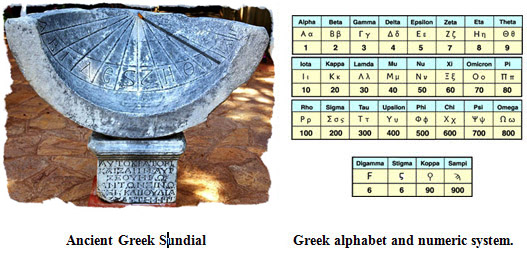
In contrast, the “nights” are divided into four separate night watches: 1)The Evening Watch, 2) the Midnight Watch, 3) the Cock-crowing Watch, 4) and the Morning Watch (Mark 13:35). So, here you have a third distinction between “days” and “nights,” they are defined by completely separate units of time. Days are defined by hours of light from the sun (Gen. 1:14). Nights are divided into four separate time units known as “night watches,” which are defined by measuring the placement of the moon and stars (Genesis 1:14). Refer to the article, Visible Stars Define the Parameters of Day and Night.
The following graphic illustrates the division of light and darkness, day and night after the sun, moon, and stars were created on day four. When created, these lights of the shamayim followed the precise time divisions laid out in the first three days. This clarifies that TIME, displayed in the newly created lights, was patterned after Yahuah Alahim’s very throne or seat of authority. Therefore, the earth’s time system was synchronized to our Creator’s preexisting pattern.
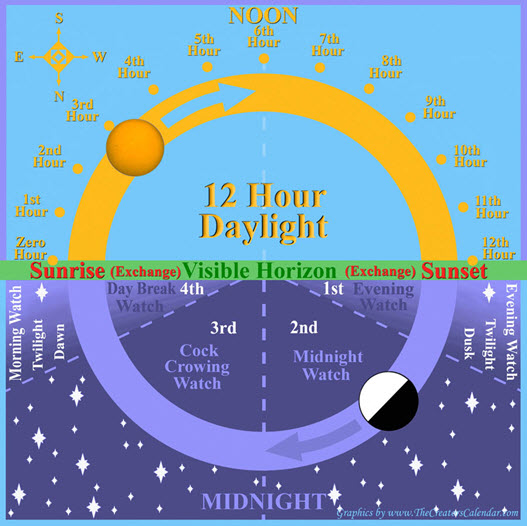 14. What is the best definition of DARKNESS?
14. What is the best definition of DARKNESS?
Darkness is the absence of pure LIGHT.
Not giving heed to Jewish fables, and commandments of men, that turn from the truth. Titus 1:14 NKJV
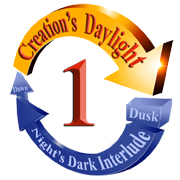 The evidence above shows that what has always been translated as “evening and morning” is actually a reference to the first and last watch of the night, which commences at sunset and ends at sunrise.
The evidence above shows that what has always been translated as “evening and morning” is actually a reference to the first and last watch of the night, which commences at sunset and ends at sunrise. “For a thousand years in Your sight are like yesterday when it is past, and like a watch in the night.” Psalms 90:4 (Refer to article: The Night is Cut Off as in Circumcision)
“[Daylight was created] . . . and then followed evening [the beginning of night], and then followed sunrise [the end of night], the first day-night cycle [24 hour cycle division of time].” Genesis 1:5
The translators incorrectly placed the word “so” in the last sentence of each of the six days of the creation storyline to represent the Hebrew word (hayah #1961). Yet, (hayah) cannot be represented by these words ever. The word (hayah #1961) means come to pass, to exist, to occur, follow, come to be, become, or happen. The dusk (beginning of night and dawn (the end of the night) represent the first and last night watches, covering the length and breadth of the night. This brings one back to the starting point position in preparation to begin a new creation day at precisely sunrise.
This is so important because descriptive language is being used to lay a foundation for the flow of TIME upon the earth for all time to come. As previously established, all the creative events occurred during the DAYLIGHT of each 24-hour cycle. As each day of creation is delineated, we can see that the Creation event was accomplished during the DAYLIGHT, then came the “evening dusk,” then came the “morning dawn,” ending the night watches.
Below is a simple illustration delineating Creation’s 12-hour day and 24-hour cycle of time as outlined in each of the six days of creation. Click on the image to enlarge it.
As simple and surprising as this is, these verses from the abovementioned word study place Genesis 1 in harmony with the rest of the Scriptures. By removing the falsified words “so” as well as “and” then replacing them with the correct words two times in each verse. Genesis 1 is in harmony with the Sanctuary services, specifically the “morning and evening” sacrifices. We can be certain this is correct because now these first five verses of Scripture are perfectly in harmony with each other.
Referring to the Word Study at the beginning of this article, each of these seven verses only found in Genesis 1 define the six days of creation, as the foundation for Scripture on when a day actually begins. However, they have all been proactively translated incorrectly to support the Rabbinical Pharisee false narrative, such as, “So the evening and the morning.” The words “so” and “and” were supplied by the translators to replace the original words and sabotage the true meaning of the text. Neither of the words “so” or “and” are even possible word choices. Utilizing the word study table above, you can see for yourself that the only options that fit appropriately in the context of Genesis 1:1-5 are the words “then came,” or “then followed” (hayah #1961).
Here is is the incorrect application that leads one to believe that the day commences with the evening:
Genesis 1:5 So the evening and the morning, day one.
Genesis 1:8 So the evening and the morning, day two.
Genesis 1:13 So the evening and the morning, day three.
Genesis 1:19 So the evening and the morning, day four.
Genesis 1:23 So the evening and the morning, day five.
Genesis 1:31 So the evening and the morning, day six.
Below, the correct words “then followed” have replaced the incorrect ones. Note also that the preface to each of these verse portions listed below are when the Creative event actually occurred, “then followed evening, then followed the sunrise, date cycle one.
Genesis 1:5 Then followed dusk (the beginning of night), then followed sunrise (the beginning of a new day), date cycle one.
Genesis 1:8 Then followed dusk (the beginning of night), then followed sunrise (the beginning of a new day), date cycle two.
Genesis 1:13 Then followed dusk (the beginning of night), then followed sunrise (the beginning of a new day), date cycle three.
Genesis 1:19 Then followed dusk (the beginning of night), then followed sunrise (the beginning of a new day), date cycle four.
Genesis 1:23 Then followed dusk (the beginning of night), then followed sunrise (the beginning of a new day), date cycle five.
Genesis 1:31 Then followed dusk (the beginning of night), then followed sunrise (the beginning of a new day), date cycle six.
Each of these six verses below refer to the “morning” (boqer #1242) and “evening” (ereb #6153) in this order with no words between them whatsoever. Even though the word “and” appears, it is only there to connect the two words in the English language.
These are correctly translated.
1 Samuel 17:16 morning and evening
1 Chronicles 16:40 morning and evening
2 Chronicles 2:4 morning and evening
2 Chronicles 31:3 morning and evening
Ezra 3:3 morning and evening
Psalms 65:8 morning and evening
The following twenty five verses declare the day precedes the night by simply stating “day and night.” These are each translated correctly.
Genesis 8:22; Exodus 13:21; Leviticus 8:35; Deuteronomy 28:66; Joshua 1:8; 1 Kings 8:59; 1 Chronicles 9:33; 2 Chronicles 6:20; Nehemiah 1:6; Nehemiah 4:9; Psalms 1:2; Psalms 32:4; Psalms 42:3; Psalms 55:10; Psalms 88:1; Jeremiah 9:1; Jeremiah 16:13; Jeremiah 33:20; Jeremiah 33:25; Lamentations 2:18; Luke 18:7; Acts 9:24; Revelation 7:15; Revelation 12:10; Revelation 20:10.
Then Alahim said, “Let there be LIGHTS in the firmament of the shamayim (heavens) to divide the DAY from the NIGHT; and let them be for signs and seasons, and for days and years; and let them be for LIGHTS in the firmament of the shamayim to give LIGHT upon the earth;” and it was so. Then Alahim made two great LIGHTS: the greater LIGHT to rule the day, and the lesser LIGHT to rule the night with the stars.
He made the stars also.Alahim set them in the firmament of the shamayim to give LIGHT upon the earth, and to rule over the DAY and over the NIGHT, and to divide the LIGHT from the DARKNESS. And Alahim saw that it was good. . . Genesis 1:14-18
Webster’s Dictionary Definition twilight — 1. The light from the sky between full night and sunrise, and between sunset and full night. It is produced by the diffusion of sunlight through the atmosphere and its dust. Webster’s Dictionary.
Now in the fourth watch of the night Yahusha went to them, walking on the sea. Matthew 14:25
Yahusha answered, “Are there not twelve hours in the day? If anyone walks in the day, he does not stumble, because he sees the light of this world.” John 11:9
Sunrise to sunset is a twelve-hour period of daylight, reckoned by hours displayed on a sundial (a method of measuring the hours of the daytime by the sun) and not by the four watches of the night.
28. According to these same verses, when might a full civil calendar date cycle begin and end?
Sunrise to sunrise for a full 24-hour day/night cycle, also called a civil calendar date.
29. When the six days of creation were completed, Alahim rested from all His work of creation. Does the record bear any statement that Alahim’s Sabbath REST was to commence with the “darkness of night,” or is it well established that this could only occur during the DAYLIGHT of DAY SEVEN?
Thus the shamayim (heavens) and the eretz (earth), and all the host of them, were finished. And on the seventh DAYLIGHT Alahim ended His work which He had made, and He rested on the seventh DAYLIGHT from all His work which He had made. Then Alahim blessed the seventh DAYLIGHT and sanctified it, because in it He rested from all His work which He had created and made. Genesis 2:1-3 NKJV
Moses declares three times in Genesis 2:1-3 that Alahim/Elohim rested on the SEVENTH DAYLIGHT instead of the NIGHT. Therefore, DAY and LIGHT are synonymous terms, as DAY-LIGHT is ruled by the SUN from sunrise to sunset.
30. For a second witness, is there another place in Scripture where Moses records when a DAY begins and when to commence the Sabbath?
Indeed, there is! It is found in Exodus 16:23-30 in reference to the manna and its application for gathering it on five workdays, with a double portion on the sixth daylight to hold over through the Sabbath hours. Here, Moses is giving detailed instructions according to the word of Yahuah.
23 Then he [Moses] said to them, “This is what Yahuah has said: ‘Tomorrow is a Sabbath rest, a sacred Sabbath to Yahuah. Bake what you will bake today, and boil what you will boil; and lay up for yourselves all that remains, to be kept until morning.’ “24 So they laid it up till morning, as Moses commanded; and it did not stink, nor were there any worms in it. 25 Then Moses said, “Eat that today, for TODAY [DAYLIGHT] is a Sabbath to Yahuah; today [DAYLIGHT] you will not find it in the field. 26 Six days [DAYLIGHTS] you shall gather it, but on the seventh day [DAYLIGHT, which is the Sabbath, there will be none.” 27 Now it happened that some of the people went out on the seventh day [DAYLIGHT] to gather, but they found none. 28 And Yahuah said to Moses, “How long do you refuse to keep My commandments and My laws? 29 See! For Yahuah has given you the Sabbath; therefore He gives you on the sixth day [DAYLIGHT] bread for two days. Let every man remain in his place; let no man go out of his place on the seventh day [DAYLIGHT].” 30 So the people rested on the seventh day [DAYLIGHT]. Exodus 16:23-30 NKJV
Notice in verse 23 that “tomorrow” is stated to be the Sabbath rest. It does not say, “Tonight” is the Sabbath rest. They were to bake everything “today,” and it would keep to the following morning, so they would not need to gather any manna, unlike the other days when it would stink and have worms by the next morning.
Notice in verse 25 that “tomorrow” had now come in the morning with sunrise, and it was the seventh-day Sabbath. In stark contrast to each of the other six days, there was no manna on the ground to be gathered at the commencement of this Sabbath daylight.
Notice in verse 26 that there had been manna to gather each of the six days that began with sunrise, but at the commencement of the seventh “daylight” (sunrise), there was none.
In verse 27, we find that some rebellious-hearted and disobedient Israelites went against Yahuah’s directions and went out on the morning of the seventh day at sunrise (because this was when the manna had been given for six days), but they found none.
Verse 28 shows that it is imperative to keep Yahuah’s commandments. This includes rightly defining and keeping the commencement of the Sabbath day from sunrise to sunset, as He demonstrated to Israel with the feeding schedule of the manna. The manna was never given at sunset, as would have been necessary to support the day beginning at sunset. The manna was always given for the commencement of the “daylight” when the Israelites could visibly see it to gather it up.
Another key point is that in verse 23, Moses tells the people that the manna will be kept until the morning of the seventh day. On all the other six days, in the morning, at the exact same point in time, the manna would stink and breed worms. Not even one word is said about the night. Below, as a second witness and “as a nail in a sure place,” it is illustrated that the “DAY” begins at sunrise. The only other options are to proactively choose to be blind and to believe Jewish fables and the false traditions of men.
Evening to Evening as a New Concept – “The original meaning of the word “day” is the period of the daylight, from sunrise to sunset, as distinct from the night, the period of darkness … in this sense the “day” is said to “decline” (Jer. 6:4) in the late afternoon, and is followed by night. Hence the earlier sequence, “day and night … The flesh of the thanksgiving sacrifice shall be eaten on the day it is offered; none of it may be kept till the next day” (Lev. 7:15), the nighttime is considered as belonging to the preceding period of daylight. From this there developed the meaning of “day” in the sense of the cycle made up of one period of daylight and one period of darkness, or according to our modern reckoning, twenty-four hours … from the natural viewpoint the twenty-four hour day begins at sunrise… However, beside this conception there arose another idea of the twenty-four hour day, according to which this daily period began at sunset… Although the earlier computation did not die out completely, the custom of considering the day as beginning at sunset became general in later Jewish times…” Encyclopedic Dictionary of the Bible, p. 497
In the 1st to 4th century A.D., when Rome pressured Israel to change its Torah Law and its full New Moon lunar calendar, the Rabbinical Pharisee Jews, under the influence of the mystic occult of Babylon, led all of Israel into adopting its ancient calendar principles. This placed Israel 180 out of sync with the worship rhythms of their Creator. Instead of the full moon for the start of years and months, they now honored the dark conjunction lunar phase. And instead of commencing their day at sunrise, they were now compelled to start their day at sunset. These new time units were to commence with darkness.
Rome declares the “DAY” begins at midnight. The Rabbinical Pharisee Jews and other Saturday Sabbatarians teach the “DAY” begins at sunset, at the commencement of darkness. Yet, a thorough study of Genesis reveals astonishing facts, leaving no room for guessing or following a false tradition of men as derived from pagan Babylonian ir jordan 3 whataburger custom traditions. When the truth is presented, and they refuse to open their eyes or ears to discern it, they will be led to believe a lie. And by their own admission, they now metaphorically walk in darkness, and the “light of truth” is not in them.
But if one walks in the night, he stumbles, because the LIGHT is not in him.” John 11:10
31. If the celebration of the sacred Sabbath day begins when the sun is going down, why would our Creator state that all nations shall praise His name and worship Him from the “rising of the sun, even to its going down?”
One must ask themselves, WHY? When so much is written on this subject in Scripture, why must sincere folks continue to cling to opposing the LIGHT? The DAY, as set forth by our CREATOR, has never begun at either sunset or midnight.
From the rising of the sun to its going down Yahuah’s name is to be praised. Psalms 113:3 NKJV
The Mighty One, Alahim, Yahuah, has spoken and called the earth from the rising of the sun to its going down. Out of Zion, the perfection of beauty, Alahim will shine forth. Psalms 50:1-2 NKJV
For from the rising of the sun, even to its going down, My name shall be great among the Gentiles; in every place incense shall be offered to My name, and a pure offering; for My name shall be great among the nations,” says Yahuah of hosts. Malachi 1:11 NKJV
The Week of Creation
Both the Rabbinical Pharisee Jews and Romans would have us believe that the week and its seventh day have cycled in an unbroken fashion since the first week of creation, with no connection whatsoever to the astronomical LIGHTS in the shamayim (heavens).
Yet, contrary to nearly 2,000 years of Rabbinical Pharisee and Roman propaganda, the only way the Sabbath can be a sign or representative of the first week of creation is if it is connected to a count from the full New Moon, His LIGHT in the shamayim in which there is no darkness. Only a Sabbath that is the fruit (unit of time) of the trinity of LIGHTS (sun, moon, and stars) can be a true memorial of the first week of creation. The correct use of the LIGHTS is the signature of the Creator, identifying His unique handiwork, the creation of TIME. In contrast, a week that cycles without end, having no ties to the LIGHTS of the sun, moon, or stars, does not qualify as an ambassador for the Creator or His preordained TIME-MEASURING mechanism in the shamayim (heavens).
The Sabbaths are His divinely designated seventh DAYLIGHTS, as they are counted from each full New Moon Day.
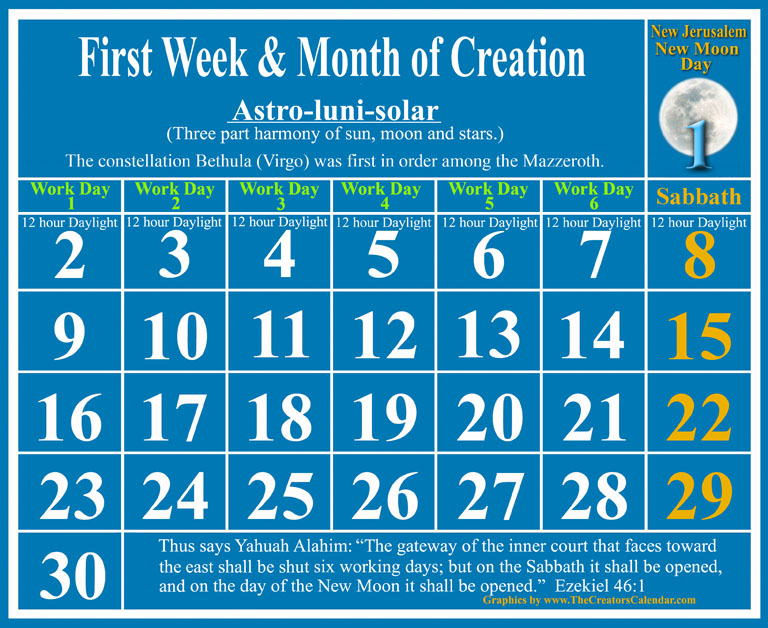 Sabbaths as Signs
Sabbaths as Signs
Moreover I also gave them My Sabbaths, to be a sign (#226 oth) between them and Me, that they might know that I am Yahuah who sanctifies them. Yet, the house of Israel rebelled against Me in the wilderness; they did not walk in My statutes; they despised my judgments, which, if a man does, he shall live by them; and they greatly defiled My Sabbaths. Ezekiel 20:12-13 NKJV
I am Yahuah your Alahim: Walk in My statutes, keep My judgments, and do them; hallow My Sabbaths, and they will be a sign (#226 oth) between Me and you, that you may know that I am Yahuah your Alahim. Ezekiel 20:19-20 NKJV
They also who dwell in the farthest parts are afraid of Your signs (#226 oth); you make the outgoings of the morning and evening rejoice. Psalms 65:88 NKJV
Your enemies roar in the midst of Your meeting place; they set up their banners [counterfeit calendars with continuous weekly cycles] for signs (#226 oth). Psalms 74:4 NKJV
We do not see our signs (#226 oth); there is no longer any prophet; nor is there any among us who know how long [time]. Psalms 74:9 NKJV
Do not learn the way of the Gentiles; do not be dismayed at the signs (#226 oth), of the shamayim for the Gentiles are dismayed at them. For the customs of the peoples are futile . . . Jeremiah 10:2-3 NKJV
He appointed the moon for seasons [#4150 – mo’edim – lunar appointed times]… Psalms 104:19 NKJV See full article: He Ordained the Full Moon for Appointed Times.
Mortal mankind will you turn away from eternal destruction, and will you answer the call to restore the children of Adam? For a thousand [astro-luni-solar] years in your sight are like yesterday when they are past, and as a watch in the night. You carry them away with a flood of sleep, yet, they shall arise in the beginning of the DAYLIGHT and like herbs, they shall spring up. In the morning sunrise, they shall flourish and sparkle, and grow in renewal, FOR THE NIGHT SHALL BE CUT OFF, as in circumcision, and wither away. Psalms 90:3-6 Full article: The Night is Cut Off as in Circumcision.
Word Definition
#1689 Theological Wordbook of the Old Testament (TWOT) corresponds to #6153 in Strong’s Concordance
‘ereb: Evening, night. Likely developed from the expression, “the setting of the sun, sunset.” Includes: to enter, to go down of the sun. . .
‘ereb is found 131 times in the OT. The phrase “there was an evening and there was a morning” occurs six times in the creation narrative (Genesis 1:5-31), delimiting the six days of divine creativity activity. This phrase would indicate that in ancient Israel a day began with sunrise. Some have felt this at variance with the Jewish practice of regarding sunset as the beginning of the next day. Cassuto, after dealing the Biblical data and the Jewish custom, concludes that there was “only one system of computing time: the day is considered to begin in the morning… This judgment appears vindicated in the employment of “ereb” in Levitical legislation respecting uncleanness. One was considered unclean because of certain acts “until the evening” (Lev. 11:24, plus thirty times). This means, that a person was unclean for the duration of the “daylight” only.
33. Is there any evidence from the Scriptural record that Yahusha haMashiach (the Messiah) assembled in corporate worship in the Temple or Synagogue during the Night Watches, between sunset and sunrise? NO!
“And they went into Capernaum; and straightway on the sabbath day [DAYLIGHT] He entered into the synagogue, and taught.” Mark 1:21
” And when the sabbath day [DAYLIGHT] was come, He began to teach in the synagogue . . .” Mark 6:2
“And He came to Nazareth, where he had been brought up: and, as His custom was, He went into the synagogue on the sabbath day [DAYLIGHT], and stood up for to read.” Luke 4:16
“And the ruler of the synagogue answered with indignation, because that
Jesus[Yahusha] had healed on the Sabbath day [DAYLIGHT], and said unto the people, ‘There are six days in which men ought to work: in them therefore come and be healed, and not on the sabbath day.'” Luke 13:14
SUMMARY – And the Weight of Evidence
- The Father and Son, together as the Aleph and Tav Alahim, created everything.
- Darkness was categorized with emptiness and nothingness, none of which are created elements but rather are an absence of intelligent design.
- The first thing the Creator called into existence was LIGHT.
- The first thing the Creator named was LIGHT, calling it DAY.
- Alahim is Himself LIGHT during the first three days of creation.
- LIGHT and DARKNESS were eternally severed from each other both visibly and by name.
- There are twelve hours in a day, commencing at sunrise and ending at sunset, as beaconed by the sunlight on a receiving sundial.
- Daylights are divided by “hours,” and nights are divided by “watches.” Evening (dusk) and Morning (dawn) are the names of the first and last Night Watch. Therefore, nights cannot be called days or the beginning of a day.
- Since darkness is the absence of LIGHT, NIGHT is the absence of day (daylight).
- As a second witness, Genesis 1:14 states that the lights in the heavens (shamayim) are to divide the day from the night.
- It would be calling the Creator a liar to state, “The day (daylight) begins at sunset when He declares in Genesis 1:16 that the greater light (sun) rules the visible daylight. For there is no visible sun after the sun has set, at which time the sun can no longer be a measuring instrument of time. The “day” is simply the period from sunrise to sunset when the sun rules in the visible sky.
- It is true that a full “civil calendar date” of 24 hours includes both the day and the night. While the day and night are opposite terms, the civil calendar date begins at sunrise and terminates with the following sunrise.
- There is both a sunrise and sunset exchange of light called twilight.
- Errors in translation have caused the assumption that the “day” (daylight) begins at “night,” as the translations say, “evening and morning,” day one, etc. The problem is one of the terms. Day and calendar date mean differing terms designating either a 24-hour period from sunrise to sunrise or a 12-hour period from sunrise to sunset.
- The Creator made all things during the DAYLIGHT. It can be seen that in all cases of each of the six days in which a CREATION EVENT occurred, it was followed by the Evening Watch of night and then followed by the Morning Watch, the last watch of the night. At sunrise, the second day began. (Genesis 1.)
- The Creator in Genesis 1:1-5, 14-16, and the Messiah in John 11:9 state that the day is twelve hours from sunrise to sunset.
- The sacred seventh-day Sabbath is to be kept according to the parameters of Genesis 1, during the DAYLIGHT hours only, when the sun rules the visible sky.
- Both the lunar months and lunar weeks, with their respective Sabbaths, were beaconed by the astronomical celestial lunar phases together with the stars, as stated in Genesis 1:14-16, to be signs and seasons.
- As a Scriptural principle, pure light metaphorically equals truth and righteousness, while darkness or any mixture of it allegorically equals error and unrighteousness.
- “From the rising of the sun to its going down, Yahuah’s name is to be praised.”
- As a second witness, the feeding schedule of the manna in the wilderness supports the DAY (daylight with the sacred portion of Sabbath) commencing at sunrise and not at sunset.
- As a third witness, Yahuah, Alahim called the earth from the rising of the sun in the east to its going down at sunset in the west, according to Psalms 50:1.
- The Scripture record provides ample evidence that Yahusha haMashiach (the Messiah) assembled in corporate worship and taught in the Temple and Synagogue during the Sabbath DAYLIGHT only. This He did as a testimony and witness for us, so you and I may be restored to His sacred TRUTHS of correct TIME-MEASURING.
Both Genesis and Exodus are shown to be in perfect harmony as they clarify in unison that the DAY and the sacred hours of the Sabbath are to be kept from sunrise to sunset, a period of 12 hours only. The 24-hour calendar date commences and terminates at sunrise.
Below is the current perspective among Rabbinical Pharisee Jewish scholars air jordan 6 toro as to the use of the Hebrew word (את – eth #853 and #854), with which I disagree. This word is used over 7,000 times and, in most circumstances, remains untranslated into our English Bibles. In many cases, it may be simply as is stated here in the Theological Wordbook of the Old Testament.
I am more convinced than ever that this word is the Tanakh’s (OT) original version of what we have come to know in the Greek language as the Alpha and Omega, the first and the last, the beginning and the end, or the promise of the slain lamb and cross. The Greeks have utilized the first and last letter of their alphabet to reveal what the Messiah declares about Himself in the final moments before He returns. Then ask yourself, what does this mean? If there is no Tanakh (OT) counterpart or original, how can the Messiah declare He is the Aleph and Tav (Alpha and Omega) fulfillment? I remain convinced that these two important Hebrew letters represent the Aleph and Tav את (paleo Hebrew ![]() ), the first and the last. It may have several other uses, as shown below, including signs and a full and complete representation of our Creator and Messiah from beginning to end. But at the end of the day, you must decide for yourself.
), the first and the last. It may have several other uses, as shown below, including signs and a full and complete representation of our Creator and Messiah from beginning to end. But at the end of the day, you must decide for yourself.
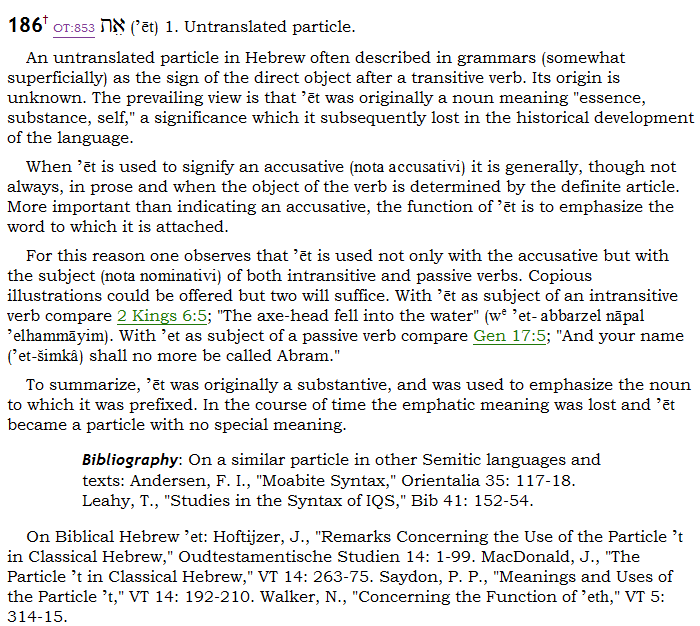
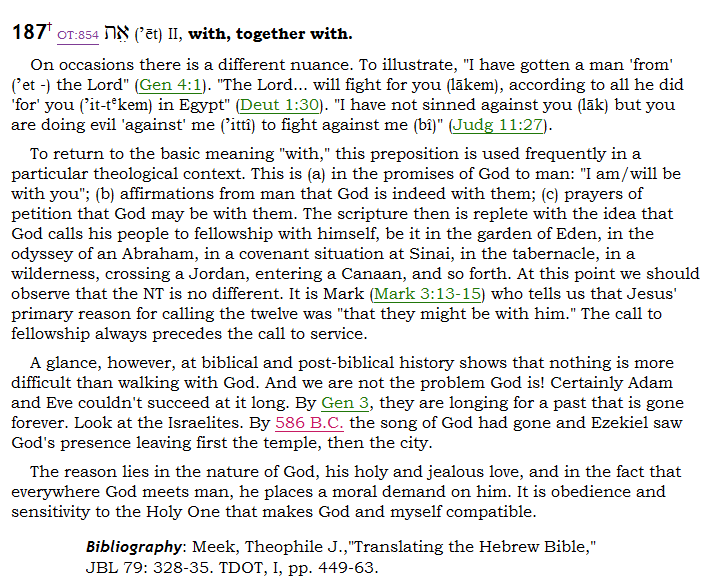
For more studies on this subject:
Sunrise or Sunset, When Does a Day Begin?

